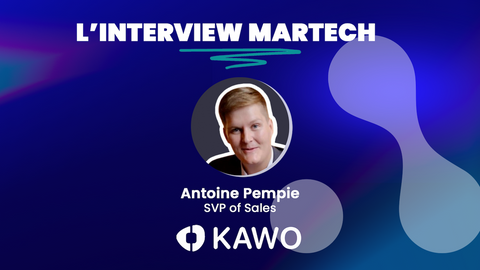MarTech.org has just published a study on changes in marketing tools for 2023. This survey, conducted among its readers, sheds light on the reasons why marketing departments replace one technology with another, and provides a better understanding of the categories of tools and the teams involved. Let’s explore the key insights from the Replacement Survey 2023.
This study has been conducted at the same period for the past four years, providing us with valuable perspective. While 2020 (the "COVID year") saw numerous software replacements, the level of tool changes has been less significant in the last three years. However, it remains notable! For example, 34% of respondents reported changing their CRM in 2020 compared to 17% this year (which still represents nearly one in five companies).


Which Marketing Technology is Most Frequently Replaced?
Nearly a quarter of respondents (24%) reported changing a marketing automation tool! This is the most frequently replaced category of tools in 2023. Marketing automation broadly refers to the automation of marketing campaigns triggered by a set of predefined conditions and user behavior (the aim being to automate "repetitive tasks"). Automation can include sending emails, SMS, segmenting contacts, or lead scoring. Market tools include Plezi, ActiveTrail, and Keap for pure-players, as well as numerous software suites (mainly CRMs offering a marketing automation component) such as Hubspot, Salesforce Marketing Cloud Account Engagement, and Adobe Marketo Engage.


Reasons for Changing Marketing Automation Tools
Some respondents, in pursuit of a more cohesive marketing tools ecosystem, cited the need for better integration and complementarity with their CRM. Others mentioned technical limitations of certain tools, which hindered their strategy: “We exceeded the limits of our ESP by wanting to create more complex campaigns and integrate audience selection. We wanted to track online and offline customer behavior and build campaigns around the customer rather than the product.”
What Motivates Tool Changes?
The drive to place the customer at the center of marketing strategies, providing increasingly personalized experiences, is clearly reflected in this study. In 2023, 38% of tool replacements involved “customer experience” tools. Improving customer experience is the primary reason for changing tools this year!

Among other reasons for changing tools, cost-saving motives come in second, cited by 37% of respondents, followed by integration capabilities (“open API”) at 36%. This reason is particularly interesting as it indicates a growing awareness among marketing professionals of evaluating their tools from a "stack" or ecosystem perspective, rather than on a case-by-case basis. Finally, other major reasons mentioned include data processing capabilities and the ability to measure ROI.
The following chart shows that these five reasons stand out significantly from the others:

Marketers Seeking Better Features to Achieve Objectives
We have just seen the main reasons for changing tools. For 42% of professionals, the response primarily involves better features (i.e., improved functionalities that will enhance customer experience). Thus, a precise analysis of features and associated use cases is essential during the selection phase of a new technology partner (our expertise applied to Social Media Management tools).

Other Frequently Replaced Marketing Technologies
SEO tools are the second most frequently replaced in 2023 (22%). Along with marketing automation, these are the only two categories of tools exceeding 20%. CRMs are also replaced to a degree of 17%. Other tools, such as Customer Data Platforms (CDPs), Digital Asset Management (DAM), and Data Management Platforms (DMPs), fall below the 10% threshold.
Surpassing the 5-Year Mark Within a Company: A Real Challenge for Software Vendors
How long had the replaced software been deployed within the company? When examining this question, it is evident that in nearly 75% of cases (72%), software does not remain within an organization for more than 5 years.
In 23% of cases, a software is replaced after two years, which may indicate insufficient deployment and team onboarding, or over-promised features.
Marketing Tool Changes: A Market Trend
The above chart reveals that 41% of replacement cases involve a tool that has been deployed for over 3 years within the company. It is difficult to imagine that the tool had not, at least partially, met expectations and objectives.
Several potential explanations include:
- Strategic brand repositioning leading to a change in technology partner
- Repositioning of the vendor (following an acquisition, merger, etc.)
- Departures on both sides altering a project
- A tool being less integrated or integrable with other currently used tools
- The purchase of a solution suite covering multiple use cases or a process rationalization…
Additionally, 66% of respondents claim to have changed at least one of their tools in the past 12 months.

Who is Responsible for Tool Changes?
Decision Timeline
In nearly 60% of cases, the decision is made by the marketing department, where operational teams play an increasingly influential role. In 66% of tool change cases, the operational team remained the same. General management accounts for 30% of tool change cases, and IT for less than 10%.
One of the final insights is the decision timeline. It is both short and considered, with 62% of changes being made between 2 and 6 months.
This study clearly shows that replacing marketing technology is a regular challenge for professionals. Marketers are willing to change marketing technologies (even very “central” applications like CRMs) if the new software offers more value and functionality. Despite the booming MarTech market, staying updated on these changes has become vital for professionals.
Evaluating new technologies is one of the main responsibilities marketers report, according to another annual Salary & Career study from MarTech.
The stakes are high as technologies are entirely linked to strategies and achieving objectives. The questions they need to answer can be numerous or complex:
- Improving customer experience
- Reducing costs
- Better leveraging data and/or better integrating technologies
- Aligning objectives, processes, data, and software
In addition to these significant challenges, the tool change process must occur within short timelines, but staying current with MarTech can be very time-consuming. At Saas Advisor, we assist our large enterprise clients with these processes, helping them save time, ask the right questions, choose the best technologies suited to their needs, and make informed decisions.
To learn more about support solutions
Download the full MarTech.org study





